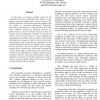122 search results - page 20 / 25 » Sequential Model Selection for Word Sense Disambiguation |
EMNLP
2010
13 years 5 months ago
2010
We introduce tiered clustering, a mixture model capable of accounting for varying degrees of shared (context-independent) feature structure, and demonstrate its applicability to i...
PRL
2006
13 years 7 months ago
2006
This paper considers the problem of designing an active observer to plan a sequence of decisions regarding what target to look at, through a foveal-sensing action. We propose a fr...
LREC
2010
13 years 8 months ago
2010
In the paper we investigate the impact of data size on a Word Sense Disambiguation task (WSD). We question the assumption that the knowledge acquisition bottleneck, which is known...
TASLP
2010
13 years 2 months ago
2010
To solve the knowledge bottleneck problem, active learning has been widely used for its ability to automatically select the most informative unlabeled examples for human annotation...
ICVGIP
2004
13 years 8 months ago
2004
In this paper, we present a holistic system for the recognition of cursive handwriting that utilizes a novel feature extraction method and a neural network. The Hough transform is...

